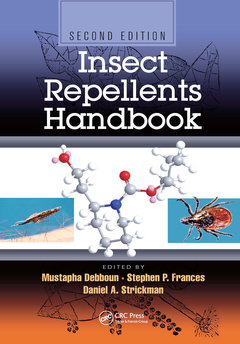Description
Insect Repellents Handbook (2nd Ed.)
Coordinators: Debboun Mustapha, Frances Stephen P., Strickman Daniel
Language: English
Subject for Insect Repellents Handbook:
Keywords
Insect Repellents; Spatial Repellency; aedes; Topical Repellents; aegypti; Essential Oils; spatial; ORs; topical; Lemon Eucalyptus; anopheles; Anopheles Gambiae; gambiae; ORNs; lemon; Area Repellent; eucalyptus; Ethyl Hexanediol; mosquito; Citronella Oil; coil; Culex Quinquefasciatus; Aedes Albopictus; Odorant Receptors; Mosquito Repellent; Antennal Lobes; Catnip Oil; Hematophagous Arthropods; Corymbia Citriodora; Insect Repellent Products; Mosquito Coils; Repellent Activity; Diaphorina Citri; Bed Nets; Maxillary Palps
Publication date: 09-2020
· 17.8x25.4 cm · Paperback
Publication date: 09-2014
416 p. · 17.8x25.4 cm · Paperback
Description
/li>Contents
/li>Readership
/li>Biography
/li>
The public has a great desire for products that prevent the annoyance of biting insects and ticks, but that desire does not always translate into sensible use of those products. Insect Repellents Handbook, Second Editionsummarizes evidence-based information on insect repellents to inform decisions by those involved with insect repellent research, development, and use. This authoritative, single-source reference makes it possible for you to quickly gain a working level of expertise about insect repellents, without having to search through the scattered literature.
The previous edition was the first comprehensive volume on this subject and quickly became the definitive reference on insect repellents. This second edition reflects the current state of insect repellent science, covers the processes involved in the development and testing of new active ingredients and formulations, and discusses the practical uses of repellents.
The book includes thought-provoking discussions on how repellents work, their neuromolecular basis of action, and whether green chemistry can provide effective repellents. It also supplies an in-depth understanding of the development of repellents including testing methods, review of active ingredients, and the use of chemical mixtures as repellents. It provides science-backed chapters on repellent use including best practices for use of personal protection products, criteria for repellent use, and insect repellents for other potential use.
PART I Science. Mode of Action of Insect Repellents. In silica Models for Development of Insect Repellents. Green Chemistry for Repelling Insect Pests. Natural Repellents Derived from Animals and Humans. Evaluation of Efficacy in Reducing Disease Incidence. PART II Development. Testing Methods for Insect Repellents. Insect Repellent Mixtures and Combinations. Formulations of Insect Repellent Products. Plant-Derived Insect Repellent Products. The Major Active Ingredients of Repellent Products and Personal Protection Systems. Area Repellents. Marketing for Efficacy, Safety, Acceptability, and Health. Product registration. PART III Uses. Strategies for Using Personal Protection Products. Best Practices for Use of Personal Protection Products. Commercially Available Insect Repellents and Criteria for Their Use. Future of Insect Repellents. Appendices and tables. Index.
Mustapha Debboun, Stephen P. Frances, Daniel Strickman
These books may interest you

Advances in Arthropod Repellents 145.45 €

Biology of Ticks Volume 1 247.28 €


